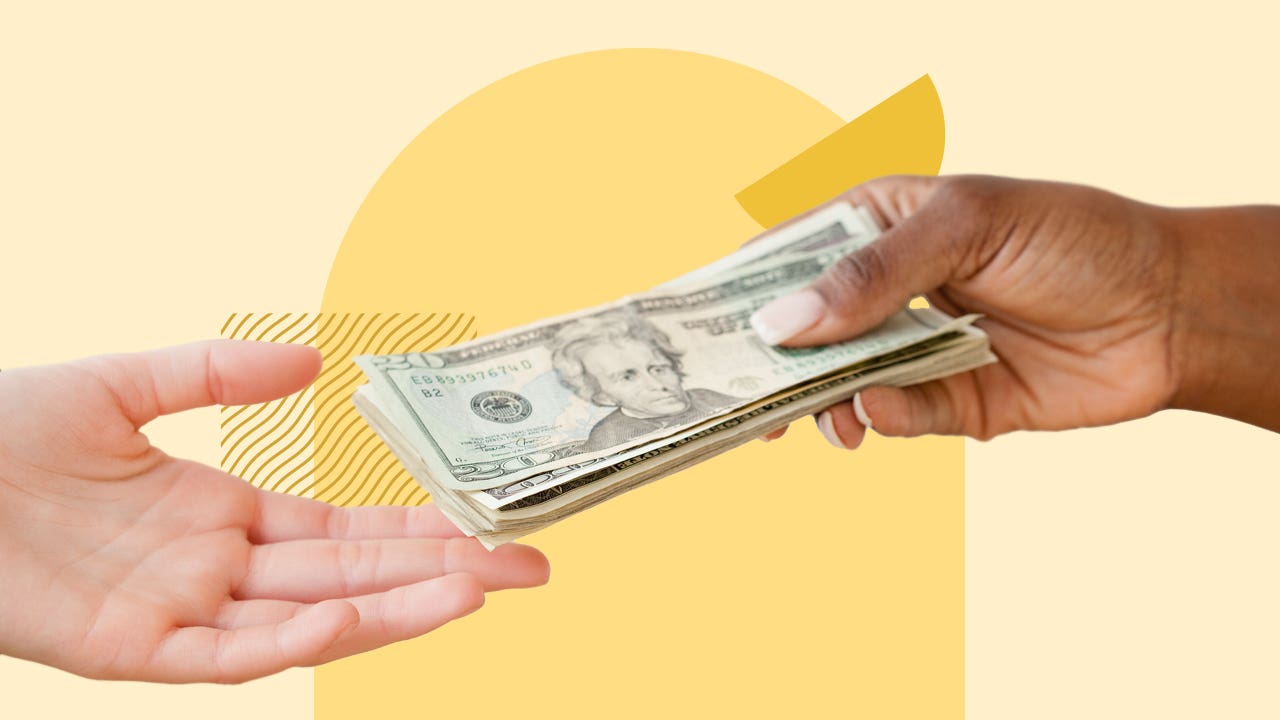Critical factors to consider when taking out payday loans amidst soaring inflation

The Bankrate promise
At Bankrate we strive to help you make smarter financial decisions. While we adhere to strict , this post may contain references to products from our partners. Here's an explanation for .
Key takeaways
- Wages haven’t fully caught up to inflation, which means your paycheck doesn’t pay for as much as it used to.
- If rent comes due or an unexpected expense hits before your next paycheck, it may be tempting to get a payday loan.
- Payday loans are one of the most expensive types of loans available, and many states ban them because they consider them predatory.
Inflation is taking a huge toll on American consumers’ spending and saving power. If you were living paycheck-to-paycheck before prices started to spike, the rise in everything from gas to eggs may make a payday loan tempting.
Despite the warnings from financial pundits about the dangers of payday lending, people turn to them when inflation rises. Why? They provide cash on the spot and don’t require any credit check.
Before you go down the “quick qualifying” path to payday funding relief, it’s crucial to understand how they could affect your financial situation as inflation stays stubbornly high.
How does inflation work?
In a nutshell, inflation occurs when the price of many goods and services you use daily, weekly and monthly rise over a sustained period. It can affect the cost of everything from home prices to rent rates, and you’ll typically see its effect in three ways.
1. It increases the cost of day-to-day expenses.
Inflation means it costs more to fill up your gas tank, fill up your fridge and heat your home. If you’re living paycheck to paycheck, spikes in these ongoing expenses can make it hard to make ends meet. This is especially true, if your salary hasn’t kept up with inflation.
You’ve probably noticed a bigger total at the grocery store. Food costs have risen 25 percent since the pandemic-induced recession began in February 2020, according to data collected from the Bureau of Labor Statistics (BLS). Energy costs are up a larger 32 percent over the same period, BLS figures also show.
2. It reduces how far your paycheck goes to cover monthly expenses.
If you’re on a fixed income, higher daily costs can translate to a depleted bank account much faster between pay periods. While inflation may vary on things ranging from margarine to lettuce to electricity to rent, it all adds up.
And don’t forget, it also affects your “want” lifestyle choices. A ticket to see your favorite singer or dinner at a restaurant will also cost more when inflation is high.
Bankrate’s take: Inflation decreases your purchasing power. For instance, if food costs rise 6.5 percent over a 12-month period, it would take $159.75 to purchase the same items that $150 could afford a year ago. In other words, your money loses value.
3. It drives interest rates higher
If you watch any type of financial news program, if the topic of inflation comes up, it’s almost always followed by a conversation about interest rates. The Federal Reserve tries to reduce inflation by raising its benchmark fed funds rate.
The idea is that higher rates slow the economy, making consumers less likely to finance big-ticket purchases.. Weakened demand may lead the companies selling goods and services to ultimately reduce their prices and hiring, and ideally, inflation decreases. However, it also means that interest rates for credit cards, personal, car and home loans head upwards. If you need to borrow money, higher monthly payments will squeeze your budget even more.
Why inflation drives up payday loan demand
Payday loans are some of the most expensive, with interest rates between 115 and 650 percent. They are considered predatory loans by many financial watchdog groups, and a number of states restrict the terms payday lenders can offer.
If payday loans are so expensive, why do so many people turn to them when inflation increases? The answer often comes down to needing the money quickly in a cash crunch.
“Research shows that, historically, low-wage and low-wealth workers struggle to make ends meet, especially during times of economic stress,” Yasmin Farahi, deputy director of State Policy and senior policy counsel at the Center for Responsible Lending, says. “And payday lenders have a history of targeting economically stressed consumers — especially in minority communities — that are underserved by traditional lenders,” she adds.
Higher rates from the Fed can also play a role, weighing on Americans’ access to credit. Nearly 1 in 4 (23 percent) Americans who were denied a loan or financial product since the Fed began raising interest rates in March 2022 say that they ended up turning to alternative financing to access the credit they needed, including applying for payday loans, a March Bankrate survey on credit denials found.
The bottom line: Inflation increases living costs for people who are already economically stressed, and payday lending seems like an easy solution. Social media search algorithms are designed to track “easy-money-fast-funding” consumer queries, and payday loan ads often promise a quick-cash relief option.
The advertised benefits of payday loans
- They’re easy to get approved for. To get a payday loan, you only need to prove you have a job, show where your income is deposited and provide bank account information. There’s no credit check, no qualifying hoops to jump through or extra paperwork.
- They can be funded quickly. If you’re still a few days away from your next direct deposit but have up to $500 of expenses to cover, you can have payday cash usually within a day, if not hours.
- The fees don’t seem that high. A 115 percent fee for a $500 loan is $57.50. Lenders often charge a flat fee for every $100 you borrow. That may seem like a small price if you need to fill the gas tank to get to work, get a prescription for a sick child or pay the electric bill before the shut off notice date.
Should I get a payday loan when inflation is high?
You should get a payday loan if you’re in a financial crisis that could threaten your basic needs. Federal data shows that payday loans are often used for essential expenses like rent or an electric bill. Despite the extremely high APRs that come with payday loans, they can be helpful in these types of financial crises.
But there’s a huge caveat: If you’re not 100 percent sure you can pay the loan off by your next paycheck, you could end up in much worse debt.
The real dangers of payday loans and high inflation
Payday loans come under extreme scrutiny because they force you to pay off a debt, usually in 10 to 14 days, with a paycheck that wasn’t enough to cover your expenses in the first place.
Inflation adds an element of surprise to a two-week payday loan payoff schedule.
Here’s an example of what could happen:
- You take out a $500 payday loan with a $60 fee.
- You need to buy ground beef and eggs; prices have increased, and your grocery bill is $20 more than expected.
- A relative who lives an hour or so away needs help because they’re sick. You visit them, and the round trip results in an extra gas pump visit in an area with much higher prices. You spend $30 to put 10 gallons of gas in the car you weren’t budgeting for.
Bottom line: The extra $50 you spent on inflated gas and grocery prices won’t leave you with enough to pay the extra $60 needed to pay off your payday loan balance. If you choose to extend it, you:
- Pay another fee for a larger loan to cover the balance of the old one.
- Could end up in the same situation in two weeks if you have an unexpectedly high water bill, electric bill, gas bill or grocery bill.
- May rack up overdraft and insufficient funds charges because the payday lender has access to your account to keep drawing money out to repay your payday balances.
And therein lies the biggest danger of payday loans: The fast two-week payoff time doesn’t give you much wiggle room to make extra money or adjust your budget for the unexpected. This often leads payday loan borrowers into a cycle of debt that’s very difficult to dig out of.
Payday lending causes significant harm for low-wage, low-worth working Americans. Payday and car title lenders charge an average 400 percent APR, depending on the state, and strip away $3 billion in fees annually from people typically earning $25,000 a year. These excessive fees lead to costly cycles of reborrowing with high rollover fees that make it even harder to repay the loan from subsequent paychecks.— Yasmin Farahi, deputy director of State Policy and senior policy counsel at the Center for Responsible Lending.
How much would a $1,000 payday loan cost?
The average payday loan has an interest rate of about 400 percent. Interest rates on personal loans are usually capped at 36 percent.
| Loan type | Amount | Interest rate | Interest accrued in 14 days |
|---|---|---|---|
| Payday loan | $1,000 | 400% | $153.42 |
| Personal loan | $1,000 | 36% | $13.81 |
Personal loans tend to have a minimum repayment term of 12 months, so you’d technically pay more in interest over the life of a loan compared to a payday loan ($205.55 vs. $153.42). That said, you’d pay that amount in monthly installments of $100.46, which is much more doable than just paying $1,153.42 in two weeks’ time. Likewise, some personal loan lenders don’t charge a prepayment penalty. In other words, you could pay off the loan ahead of schedule and save on interest.
Alternatives to payday loans
If you’re struggling to pay your bills between paychecks, consider other options to bridge the gap.
-
When inflation starts eating into your take-home pay, it’s time to consider how you spend money. Make simple adjustments by eating out less, removing subscriptions or paid apps you don’t use and buying generic food brands.To cut costs, shop for lower car insurance or reduce your cell phone plan. The savings on each step may be small but could add up to enough to avoid needing a payday loan.
-
There are various ways to make extra money daily, including food delivery, passenger driving like Uber or Lyft or shopping gigs like Instacart. You can work as many or as few hours as you need and get paid the same day.You can also sell things online or consider renting a room in your home and use the cash to build an emergency savings account
-
If you have a credit card that isn’t maxed out, you may be able to get an advance to cover expenses in a crunch. You’ll have more time before the payment is due, which means you could take on extra overtime or work hours to pay the balance off.
-
Bad credit personal loans are sometimes available for borrowers with scores as low as 500. They can be funded within one business day of approval, and the cash can be used for just about any purpose. The drawback is rates may be as high as 36 percent, and the shortest term is usually one year.
-
A peer-to-peer loan may be worthwhile if you don’t qualify for bad credit loans. You’ll be matched with a group of investors versus just one lender. They may be willing to share the risk of loaning you money if individual banks keep turning you down.
-
You may be eligible for a loan if you’ve contributed to a 401(k) retirement fund. It usually takes several weeks to get money, and you won’t be able to borrow all the money you have vested. Another note: Your take-home pay will be reduced to cover the monthly 401(k) loan payment, so make sure you adjust your budget for the lower net amount.
-
If you need help immediately, federal and local programs are available. For example, the Emergency Rental Assistance Program is set up to help families cover rent and utility costs in times of need. If food costs are a concern, it could be worth visiting your local food bank to ease the burden. It is also worth checking if your local community has any community service agencies that offer help with expenses like rent and back-to-school expenses for kids.
-
Though not the most comfortable thing to do, you can always ask friends or family to lend you money. Set realistic expectations as to when you’ll be able to pay them back, when asking for the loan. However, circumstances can change at any time. If you foresee having trouble repaying the money before your original timeline, communicate this to them. This is essential to avoid damaging your personal relationships.
The bottom line
As inflation remains above normal levels, people are struggling to pay their bills and looking for ways to supplement their income. While payday loans are a quick and easy way to get food on the table or fill your tank with gas, they are incredibly dangerous.
A payday loan could launch you into debt and ruin your credit. If you are struggling financially and considering a payday loan, consider the alternative solutions listed above and see if they will work for you before making that decision.
Related Articles

Emergency and payday loan alternatives that could save you money

Payday loans vs. installment loans: One is a much better option

